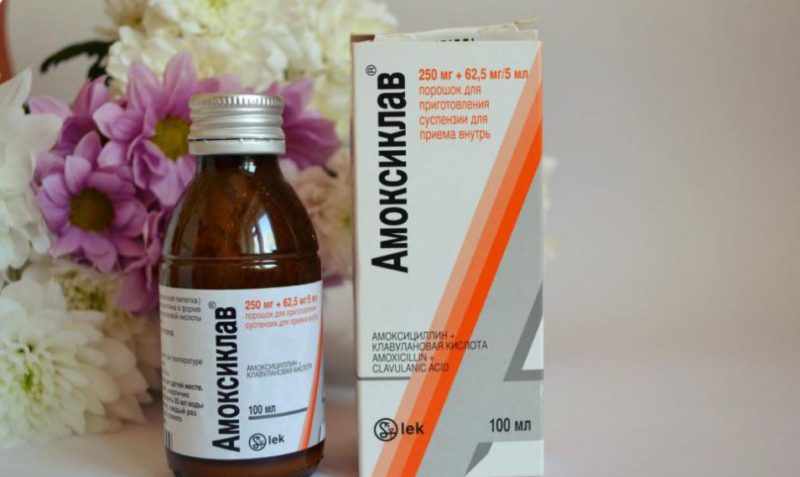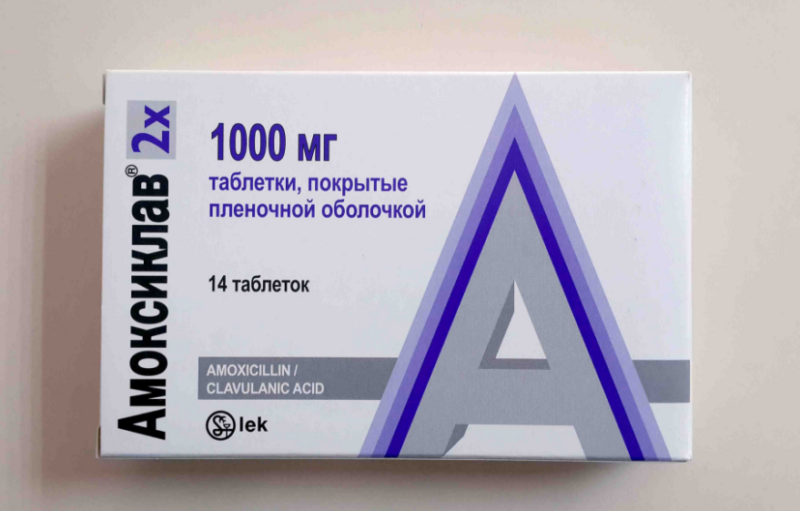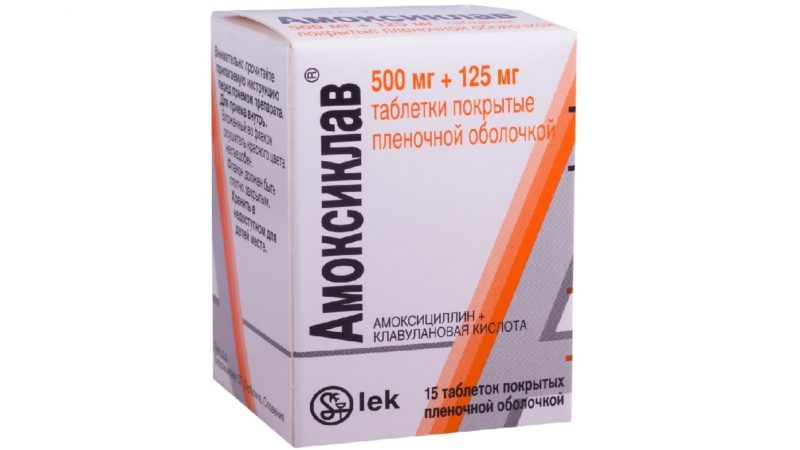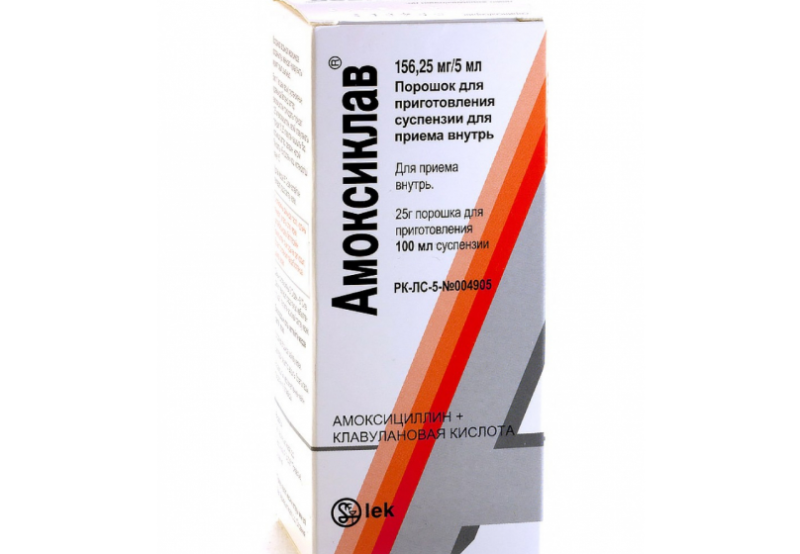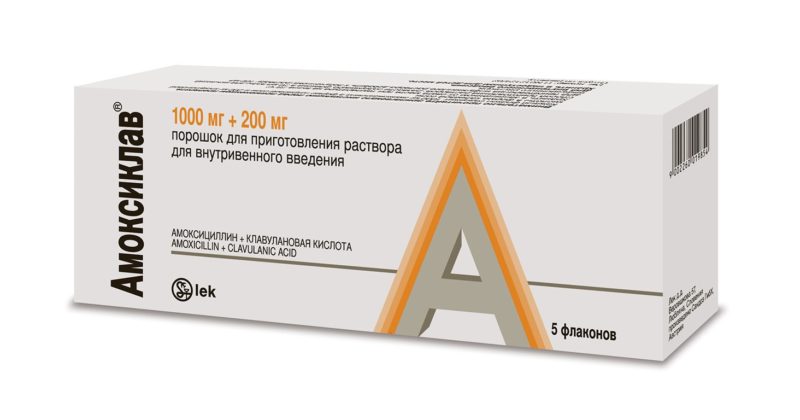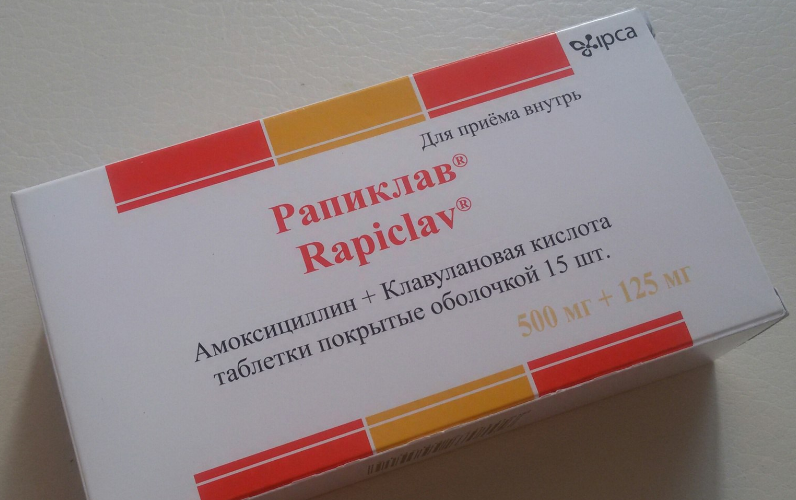Amoxiclav is a relatively safe antibiotic-based drug that cures complex diseases caused by bacteria. Recommended for children and adults. Allowed to pregnant women, as well as nursing. It is unacceptable to start treatment with the drug without studying the attached instructions. How to take Amoxiclav is described below.
Material Content:
- 1 Forms of release and composition of the drug
- 2 Which group of antibiotics belongs
- 3 What helps Amoxiclav
- 4 Instructions for use and dosage for children and adults
- 5 During pregnancy and lactation
- 6 Drug interaction
- 7 Can I drink alcohol while taking the drug
- 8 Contraindications, side effects and overdose
- 9 Antibiotic Analogs
Forms of release and composition of the drug
The medication is made in three forms, convenient in appropriate cases:
- Film-coated tablets 250/500/875 mg.
- The suspension assigned to children, which is prepared independently from the powder, is 125/250/400 mg.
- Powder for injection 500 and 1000 mg.
Structure:
- One tablet contains active ingredients - amoxicillin, clavulanic acid. Auxiliary compounds and serving as shell components - colloid of silicon dioxide, croscarmellose sodium, magnesium stearate, MCC, crospovidone, polysorbate 80, titanium dioxide.
- The powder for oral administration, in addition to the active components, contains saccharin and sodium benzoate, xanthan gum. The composition contains flavorings: strawberry, cherry, lemon.
- The powder for dilution of the solution in addition to the dominant components contains sodium and potassium salt.
Which group of antibiotics belongs
The effectiveness of Amoxiclav is due to the activity of a combination of two main active ingredients:
- Amoxicillin is a partially synthetic antibiotic of the penicillin group. It has an extensive bactericidal spectrum of activity.
- Clavulanic acid - blocks the development and spread of beta-lactamases - enzymes produced by infectious microorganisms, the destruction of which is susceptible to amoxicillin.
Specificity of action: amoxicillin actively destroys the vast majority of infectious bacteria.
The bactericidal effect of amoxicillin does not include resistant microorganisms that produce enzymes that can neutralize it. It destroys the cell walls of microbes by disrupting the synthesis of a structural component - peptidoglycan. Inhibition causes the weakening and vulnerability of the walls of bacterial cells, which inevitably leads to their death.
Clavulanic acid detects and inhibits beta-lactamases in those bacteria that resist penicillin antibiotics, as well as cephalosporins. It provides amoxicillin with resistance to enzymes of resistant microorganisms, due to which full antibacterial activity is carried out. The clinical inefficiency of the independent struggle of clavulanic acid with microbes is caused by the similarity of its structure with the structure of beta-lactam antibiotics.
Amoxiclav acts on strains susceptible to amoxicillin, producing beta-lactamases, on gram-negative and gram-positive anaerobic and aerobic bacteria.
The presence of potassium clavulanate in a therapeutic agent is due to its ability to protect amoxicillin from destruction by specific enzymes, thereby increasing the spectrum of antibiotic action of the antibiotic.
What helps Amoxiclav
The drug is used exclusively after individual prescription by a doctor for the treatment of infectious diseases that are provoked by the corresponding bacterial strains. Highly effective in acute and chronic form.
The medicine copes with the following problems:
- Upper respiratory infection. For example, pharyngitis, pharyngeal abscess, tonsillitis, otitis media, sinusitis.
- Diseases of the lower respiratory organs, such as bronchitis, pneumonia.
- Soft tissue lesions, skin damage through infection of burns, bites and other wounds.
- Infectious inflammation of the genital, urinary systems (urethritis, pyelonephritis, cystitis), biliary tract (cholecystitis).
- Bacterial bone damage.
- Odontogenic inflammation (if bacteria have penetrated the tooth tissue).
Instructions for use and dosage for children and adults
After studying the instructions for use of the drug, it is recommended to save it for the next possible use of Amoxiclav.
It is also useful to follow a few more recommendations:
- For any question of interest regarding how to take Amoxiclav, the answer must be sought in the instructions or at your doctor.
- If this medicine is prescribed by prescription for one patient, then you can use the drug only to him. Another person who has similar symptoms of the disease cannot be taken an antibiotic without a doctor’s prescription. Because the drug can cause serious harm to health.
- The treatment regimen and the amount of the drug taken is set only by the doctor, taking into account the degree, course of infection, weight, age, functional state of the patient’s liver and kidneys. An independent decrease in the amount of the drug will reduce the antimicrobial concentration of the antibiotic in the blood, therefore, the treatment result may be incomplete.
- It is not recommended to arbitrarily interrupt the use of the drug, not having sustained the course duration noted by the specialist.A bacterial infection can be reactivated, microorganisms will develop resistance to this antibiotic and the like.
To cancel (or replace by another means) Amoxiclav can and should be in case of hypersensitivity to its components or when side effects occur.
An antibiotic in the form of tablets or suspensions can be drunk before or after a meal or at the same time as a meal. Thus, absorption is optimized, the likelihood of side effects with respect to the gastrointestinal tract is reduced.
The highest concentration of the drug in the blood plasma is recorded an hour after consumption.
Film-coated tablets
Amoxiclav tablets are taken if the patient's weight is more than 40 kg or his age is more than 12 years.
Recommended admission mode:
- Mild, moderate disease, dosage per day: 1 tablet. (375 mg) every 8 hours. Or a tablet (625 mg) every 12 hours.
- If a severe form of the disease (for example, a threat of inflammation of the respiratory system) - 1 table. 850 mg twice daily.
- The daily norm of potassium clavulanate for an adult is 600 mg, for a child - 10 mg per 1 kg of weight. Amoxicillin for adults - 6 g, for a child - 40 mg per 1 kg of weight. Applies to all forms of Amoxiclav.
It is important to note that the use of Amoxiclav requires strict adherence to the dosage established by the attending specialist. You can not appoint 625 mg in one tablet to replace two tablets of 375 mg. The ratio of basic substances is different and, thus, the concentration is disturbed.
The duration of the course is 5-14 days, set by the therapist or pediatrician. If treatment takes longer than two weeks, this should confirm a secondary medical examination. Without appropriate indications, a longer use of the drug will provoke severe dysbiosis.
Powder for suspension
Basically, Amoxiclav suspension is designed for use by children. The powder is produced and packaged in a box with a special measuring syringe or spoon, with the help of which the correct dosage is carried out.
The dose is calculated depending on the weight of the baby and the complexity of the condition. Usually it is 30 mg per 1 kg of body weight, give the child twice a day.
Amoxiclav for children from 3 months of age - 20 mg per 1 kg of weight. For the treatment of severe inflammation and infectious processes (including sinusitis, pneumonia, etc.), 40 mg / 1 kg of weight is taken every 12 hours.
The highest daily dose of amoxicillin to a child is 45 mg per 1 kg, clavulanic acid - 10 mg per 1 kg of body weight.
Amoxiclav for adults: 6 g per day maximum, the maximum daily amount of potassium clavulanate is not higher than 600 mg.
Lyophilized powder for injection
For injectable antibiotic use, a powder is produced. A solution prepared on its basis includes sodium salt (500 or 1000 mg) and potassium salt (100 or 200 mg).
The intravenous method is practiced in the treatment of inflammation of the abdominal cavity. And also for the provision of preventive measures in surgery in the postoperative period.
Intravenous administration is carried out in a medical institution, in a dosage adequately calculated by the doctor, under the supervision of a specialist.
During pregnancy and lactation
When used by women while carrying babies and when breastfeeding, the antibiotic penetrates the placenta and into milk. The amount of basic substances released in the second case is insignificant. This means that it is permissible to take Amoxiclav in case of revealing serious indications and only if the potential effect exceeds the likelihood of negative consequences for the fetus.
A baby who is breastfed will have the likelihood of sensitization (increased sensitivity to an antibiotic), the development of candidiasis of the oral mucosa and the appearance of diarrhea.
It is recommended to interrupt breastfeeding if there is a need to take Amoxiclav.
Drug interaction
The effect of the antibiotic is slowed down if used with glucosamines, antacids, and medications that stimulate intestinal activity. Absorption is increased if taken together with preparations containing vitamin C (for example, ascorbic acid).
Medicines that can close tubular secretion, such as NSAIDs, diuretics, phenylbutazone, increase the concentration of amoxicillin.
Amoxiclav can increase the hepatotoxicity of methotrexate if used together.
It is strongly recommended that you exclude the possibility of concurrent administration with disulfiram.
Use with caution with anticoagulants. Amoxiclav increases the prothrombin gap. Amoxicillin and rifampicin are antagonists that reduce the bactericidal effect of each other.
Bacteriostatic antibiotics are highly likely to reduce Amoxiclav activity while using it.
Probenecid multiplies the concentration and persistence of amoxicillin in the circulatory system. Therefore, the joint reception of these funds is not recommended, because it inhibits the withdrawal of amoxicillin from the body.
Can I drink alcohol while taking the drug
The use of alcohol-containing drinks during antibiotic treatment is strictly excluded. Alcohol has a toxic effect on the body. Amoxiclav treatment reflects a significant burden on the liver (like alcohol). A double “blow” to one organ can provoke serious exhaustion of the patient’s body.
Consequences of using Amoxiclav with alcohol:
- Noise hallucinations.
- Indigestion, nausea, vomiting, disruption of the digestive tract.
- Anaphylactic shock, shortness of breath (affected patients in the reviews stated that they were suffocating).
- Chest pressure.
- Heart palpitations, tachycardia.
- The onset of panic attacks.
- Rapid decrease in blood pressure. High probability of loss of consciousness.
- Decreased immunity.
- Skin reactions, pigmentation, bruising.
The duration of such manifestations is associated with individual characteristics, antibiotic doses and the amount of alcohol consumed.
In order to restore health through medication, and not get into the ward with deterioration, it is strongly recommended to refrain from drinking alcohol-containing drinks. For 3-4 days after the termination of the course of therapy with Amoxiclav, the use of alcohol is also prohibited.
Contraindications, side effects and overdose
Side effects may not occur, this is due to individual susceptibility to the components of the drug.
Often, these effects from the treatment are temporary, are insignificant and weakly manifested:
- Digestive tract disorder: gas, gastritis, vomiting, impaired appetite, diarrhea.
- Allergic reactions: vasculitis, edema, shock.
- Anemia, reversible leukopenia.
- The development of superinfection.
- Specific discomfort and pain in the body, stomach, head. Including loss of sleep, dizziness, anxiety, disorientation, increased excitability of the nervous system, lethargy, inadequacy.
- The skin can react with dermatitis, itching, burning and rash.
- In case of impaired renal activity, convulsions may occur if the antibiotic is used in an overestimated dose.
Reception is prohibited in such cases:
- With intolerance, susceptibility of the patient to any of the constituent substances of the drug.
- A person's weight has not reached 40 kg or he is less than 12 years old. Children can be treated with Amoxiclav only with the appointment of a doctor.
- Lymphocytic leukemia, Filatov's syndrome.
- Disorder of the liver functions provoked by the use of penicillin (for example, cholestatic jaundice).
- Reception in one period together with other types of antibiotics. For example, with macrolides, tetracycline, sulfonamide.
It is permissible to use the drug with special precautions when identifying diseases of the gastrointestinal tract or kidneys, pseudomembranous colitis.During pregnancy and lactation, an antibiotic can be taken in parallel with the use of medications to help prevent blood clots.
A theoretical warning about an overdose of Amoxiclav is present in the list of side effects. In practice, in cases of non-compliance with the prescribed instructions or with low qualification of the attending physician, cases of exceeding the dose were observed. First of all, the organs of the gastrointestinal tract, ENT (development of an allergy), the liver (which can lead to hepatitis on the background of the drug), the heart are affected.
If an overdose occurs, gastric lavage is required, an immediate appeal to a medical institution.
Antibiotic Analogs
Similar drugs with similar therapeutic effects: Ecoclave, Clavocin, Amovicomb, Medoclav, Amoksiklav Kviktab, Flemoklav, Arlet, Baktoklav, Rapiklav, Verklav, Liklav, Taromentin, Augmentin, Solutab, Moksiklav and others.
Amoxiclav and analogues are recognized as the most effective drugs from the penicillin group.
Based on the analysis of consumer reviews, a positive result occurs almost instantly. Amoxiclav is more effective than single amoxicillin, due to the clavulanic acid contained in the composition.


